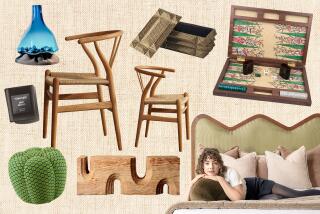FURNISHINGS : Fresh Look Is Just a Stone’s Throw Away
- Share via
Yabba dabba doo. Fred and Wilma Flintstone have come to the big screen, just in time to greet the real-life stone furnishings and accessories that are rocking the ‘90s.
Stone furniture dates back to the time of the first cavemen. It was nothing fancy, just a jagged slab of sandstone or a flat hunk of shale. The centuries rolled by, styles changed, but stone endured. And today Fred, Barney and the rest of the gang will be gratified to find that their stone-age furniture is making a splashy comeback.
These days, artists, interior designers and retailers are romancing the stone, and the next wave of designers is primed to follow suit.
At the recent International Contemporary Furniture Fair in New York City, Jenna Goldberg, a graduate student at the Rhode Island School of Design, introduced her “bone chair,” a prehistoric-looking seat with earth-tone leather upholstery, a carved wood “bone” back and a grassy rope skirt.
With a nod to whimsy, Goldberg also whipped up a a pair of matching mules, which Betty Rubble would surely have worn in the movie, while washing the dishes with water filtered through an elephant’s trunk.
In terms of furniture, stone’s appeal is largely in the fun of the material. You do a quick double-take upon entering a room and encountering the freshness, the surprise, the sheer eccentricity of a chunky cement slab table or a porous stone vase, not to mention the wacky joy found in Edward Zucca’s caveman television, which features a stone where the TV screen should be and antennas made of curved horns.
“It’s an oddball thing, really,” said Zucca, an artist who doesn’t like TV violence. “The screen is a rock that I got from my back yard. I wanted to use a primitive material to encourage meditation. You look at the screen and use your imagination.”
Social commentary aside, creative folk wax eloquent on the virtues of the common rock.
“I adore the material,” said Thomas Hucker, a New York City-based artist who created a craggy, rough-edged table with a gray stone top. “Stone is honest. Stone is gutsy. It has mass. It has texture. There’s a depth to it, a quality to the composite that is absolutely wonderful.”
Designers like to point to stone’s illustrious history as a building material--used for defense, for shelter and as an early framing device (see Roman arch).
Throughout most of this century, stone furniture has mainly been associated with the garden. Think rustic stone settees, carved benches and playful ornaments, and you get the picture.
In the 1980s, faux stone was the rage, as in floors, walls, ceilings and furnishings that replicated the rich look of Cararra marble and travertine flushed with blood-red veins. Now the trend is toward the real thing. No fakes or substitutes. Just the sheer raw power of rock.
“The whole idea of ‘faux’ is instant gratification. It was part of the ‘80s free-for-all, a fantasy. It really wasn’t necessary that the stone be real,” said Alex Locadia, a designer who has fashioned many different objects from the real McCoy. “Now, in the ‘90s, people are much more interested in using honest materials--wood, metal, stone. Maybe they’re doing it out of guilt, or maybe there’s just more openness about what’s real.”
In putting the ancient material to contemporary uses, Locadia designed a watch with a stone face, a white stone phone and a stone radio with a curlicue metal antenna.
“When you put stone into the mix, it looks somewhat unorthodox,” Locadia said. “It’s a mix of high-tech and non-tech. Stone is so basic, but when you place it against technology, it takes you for a spin.”
Interior designers also are mining the stone renaissance, using stone to enhance and enliven decor.
“Stone unquestionably has a vibrant, tactile sensation, whether it’s smooth marble or rough Belgian block,” said Fred Kentop, a Long Island interior designer.
For one client he created a “geological” fireplace, using bars of feldspar embedded with nodes of quartz crystals (“very craggy and naturalistic”). In another home, he fashioned an archway with carved blocks (“rough, uneven, exotic and ethereal”).
Friends of Goldberg, meanwhile, have nicknamed her creation the “Flintstone” chair.


